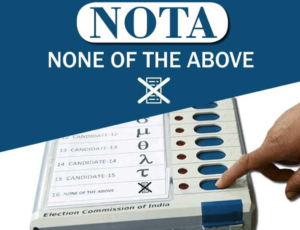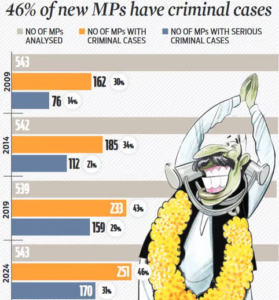Introduction
- Context: The Supreme Court recently asked the Election Commission of India to respond to a plea seeking fresh elections to constituencies where NOTA (none of the above) wins majority votes.

What is NOTA?
- NOTA was introduced to give voters a right to reject the candidates put up by the political parties.
- Electronic Voting Machines (EVM) in India have the ‘None of the Above’ (NOTA) button at the bottom of the list of candidates.
- The NOTA option on electronic voting machines has its own symbol — a ballot paper with a black cross across it.
- The NOTA option is meant only for universal adult suffrage and direct elections.
-
- The option is available to the public only during Lok Sabha, State Assembly and Panchayat and Municipal body elections.
- Implementing the Supreme Court order, the Election Commission of India (ECI) withdrew the provision of None of the Above (NOTA) from elections to Rajya Sabha and Legislative Council in States.
-
When was NOTA first used in India?
- The EC, on the directions of the SC, introduced the NOTA option for the first time in the 2013 Assembly elections.
-
- In 2013, India became the 14th country to institute negative voting through NOTA.
-
There was a similar provision before NOTA. What was it?
- The voters had the right of choosing none of the contesting candidates earlier as well. But before introduction of NOTA, a voter had to inform the polling officer of her decision.
- This provision went against the basic principle of secret voting as practiced in India, according to Section 128 of the Representation of People’s Act.
- NOTA restored secret ballots in the election. A NOTA vote does not require the involvement of the presiding officer.
Read also: Green Technologies: Meaning, Types, Opportunities and Challenges | UPSC
What difference does NOTA make?
- The NOTA option cannot impact the results of the elections.
- The NOTA option on EVMs has no electoral value.
- Even if the maximum number of votes cast is for NOTA, the candidate getting the most of the remaining votes would be declared winner.
- NOTA votes are treated as invalid or no votes.
- It is not a negative vote, but a neutral one that records a voter’s rejection of candidates.
How is the ‘NOTA’ button on the EVMs important in a democracy?
- NOTA provides democratic means to express resentment anonymously rather than boycotting the polls outright.
- Voter’s participation is the essence of democracy. Introducing a NOTA button can increase the public participation in an electoral process.
- NOTA option gives the voter the right to express his disapproval with the kind of candidates that are being put up by the political parties.
-
- When the political parties realize that a large number of people are expressing their disapproval with the candidates being put up by them, gradually there will be a systemic change and the political parties will be forced to accept the will of the people and field candidates who are known for their integrity.
-
- For democracy to survive, it is essential that the best available men should be chosen as people’s representatives for proper governance of the country.
-
- Thus, in a vibrant democracy, the voter must be given an opportunity to choose the ‘None of the Above’ (NOTA) button, which will indeed compel the political parties to nominate a sound candidate.
-
- Furthermore, a provision of negative voting would be in the interest of promoting democracy as it would send clear signals to political parties and their candidates as to what the electorate thinks about them.
What is ‘Right to reject’? How is it part of fundamental right of freedom of speech?• If the right to vote is a statutory right, then the right to reject a candidate is a fundamental right of speech and expression under the Constitution.
• Right to reject implies that a voter while voting has every right not to opt for any of the candidates during an election. Red Alert Constituencies• These are those which have 3 or more candidates with criminal cases contesting elections. |
Effectiveness of NOTA
- More than ten years after a Supreme Court judgment paved way for introduction of the NOTA (None of the Above) button on Electronic Voting Machine (EVM) for polls, the number of voters choosing it still remains low, with the experts dubbing it as a “toothless tiger” with no implications on the results.
-
- As many as 63,47,509 voters pressed the NOTA button, choosing ‘None Of The Above’ in the 2024 Lok Sabha elections.
- While 1.06 percent voters pressed the NOTA option in 2019 translating to 65,20,000 NOTA votes, as many as 1.08 per cent voters pressed the NOTA option in the 2014 Lok Sabha polls.
-

- NOTA has made no difference as far as criminality is concerned, in fact the number of candidates with criminal cases has increased. A record 46 percent of the 543 newly elected members in 2024 Lok Sabha elections have criminal cases registered against them. In 2019, the share of MPs with criminal and serious criminal cases increased to 43% and 29%.
- The percentage of NOTA votes in seats reserved for the Scheduled Castes and the Scheduled Tribe has been slightly higher, which may indicate there are more grievances among these groups.
- Despite the above drawbacks, in many constituencies, NOTA polled more votes than winning margin and thus will encourage the parties to review their candidates in future.
How can we make NOTA more effective?
- Recently, a petition was filed in the Supreme Court to ask the Election Commission (EC) to conduct fresh elections in constituencies where NOTA (none of the above) wins majority votes.
- From 2018 onwards, several States like Maharashtra, Haryana, Delhi and Puducherry began to treat NOTA as a “fictional electoral candidate”. These State Election Commissions declared that if NOTA emerged as the winner in any election, there would be a mandatory re-poll.
- The petition also urged the Court to direct the EC to frame rules stating that candidates who poll fewer votes than NOTA should stand debarred from contesting elections for five years.
Answer Writing Practice for UPSC Mains
Topic: Salient Features of the Representation of People’s Act. (GS Mains Paper 2)
- Critically analyse the importance of the ‘None of the Above’ (NOTA) button on the EVMs in a democracy? (Answer in 250 words)
Read this: Key Events, Initiatives, and Movements Against British Rule in India
Model Answer
The inclusion of the ‘None of the Above’ (NOTA) button on Electronic Voting Machines (EVMs) in democratic elections represents a significant development, providing voters with a formal mechanism to express dissent against all available candidates. This feature’s critical importance can be analyzed from several perspectives: democratic expression, voter engagement, electoral integrity, and political accountability.
Democratic Expression:
NOTA embodies the democratic principle of choice by ensuring that voters are not compelled to select a candidate they do not support. It extends the freedom of expression within the electoral process, allowing voters to actively reject all candidates without abstaining from the voting process entirely. This provision can be seen as a reflection of true democratic values, where voters have the right to express dissatisfaction with the quality of candidates.
Voter Engagement:
The NOTA option can potentially increase voter turnout by providing a meaningful way for disenchanted voters to participate. In the absence of a NOTA option, voters dissatisfied with all candidates might choose to abstain from voting, leading to lower voter engagement. By enabling these voters to cast a vote of dissent, NOTA keeps them involved in the democratic process, ensuring their voices are still counted and heard.
Electoral Integrity:
From the perspective of electoral integrity, NOTA can serve as a check against coercion and vote-buying. Voters who might otherwise be pressured into voting for a particular candidate can use NOTA to safely express their true preference. This aspect enhances the overall integrity of elections, as it provides a safeguard against manipulative practices that can undermine the fairness of the democratic process.
Political Accountability:
NOTA also promotes political accountability and encourages better governance. When a significant number of voters opt for NOTA, it signals widespread dissatisfaction with the available candidates and the political parties they represent. This can compel political parties to nominate more suitable and appealing candidates in future elections, fostering a competitive environment where merit and public approval are prioritized.
However, the effectiveness of NOTA is contingent on its consequential impact. In many jurisdictions, NOTA currently does not influence the election outcome directly, as the candidate with the highest votes still wins, even if NOTA receives a significant share. For NOTA to truly enhance democratic processes, its implementation must be accompanied by mechanisms that hold parties accountable, such as re-elections or disqualification of candidates if NOTA secures a majority.
In conclusion, while NOTA enriches democratic practice by empowering voter choice, its potential is fully realized only when complemented by reforms that ensure political accountability and electoral integrity.
Reference:
- https://www.thehindu.com/elections/lok-sabha/on-plea-for-fresh-elections-in-places-where-nota-emerges-winner-sc-seeks-ec-reply/article68109543.ece
- https://www.deccanherald.com/elections/india/httpsadrindiaorgcontentanalysis-nota-votes-2013-2017-0-3049567
- https://indianexpress.com/article/cities/ahmedabad/lok-sabha-election-results-2024-nota-votes-rank-3rd-in-24-of-25-seats-9374784/
- https://www.newindianexpress.com/nation/2024/Jun/06/record-46-of-newly-elected-lok-sabha-mps-facing-criminal-cases-study
- https://www.thehindu.com/news/national/nota-a-toothless-tiger-with-no-implications-on-results-adr-expert/article67931927.ece

